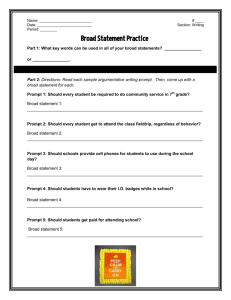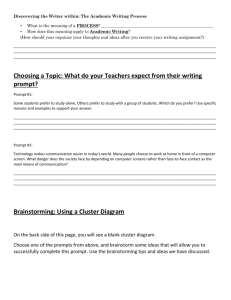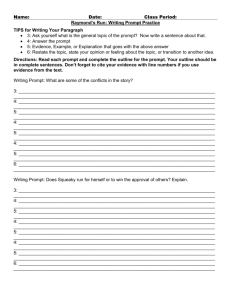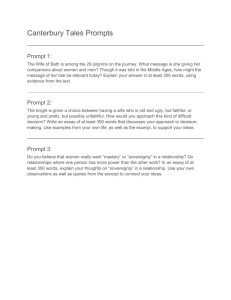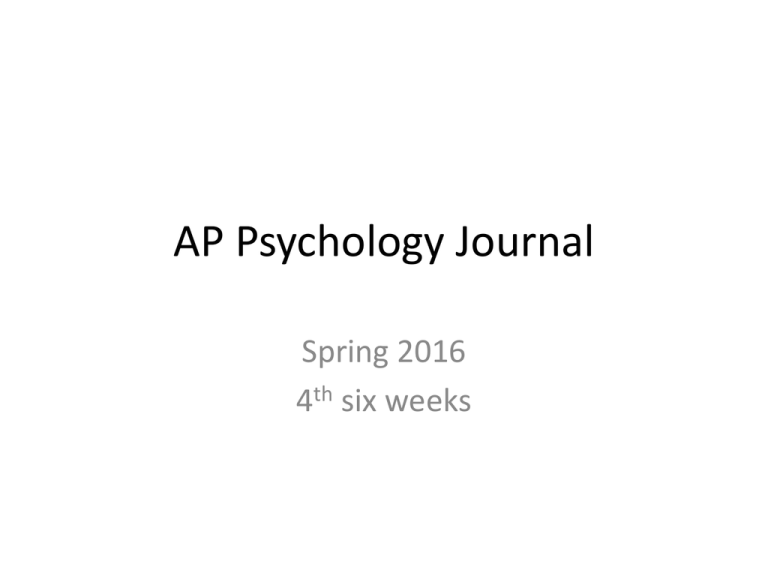
AP Psychology Journal
Spring 2016
4th six weeks
Today’s lesson 1/5/2015:
•
•
•
•
Memory Activity
Journal prompt: Pervasive role of memory
Lesson: Theories of Memory
Lesson Review: Categorizing Different types of
Memories
• Video:
– Understanding the Mysteries of Memory, part I.
– Take notes for extended journal assignment
– No other work during the video!
Memory activity
• Write in your journal the answers to the
question the teacher asks.
Memory Activity
Snow White and the 27 Dwarves
•
•
•
•
•
•
•
•
•
Grouchy
Gabby
Fearful
Sleepy
Smiley
Jumpy
Hopeful
Shy
Droopy
•
•
•
•
•
•
•
•
•
Dopey
Sniffy
Wishful
Puffy
Dumpy
Sneezy
Lazy
Pop
Grumpy
•
•
•
•
•
•
•
•
•
Bashful
Cheerful
Teach
Shorty
Nifty
Happy
Doc
Wheezy
Stubby
Journal Prompt 1/5/2015
Learning
Objective
3.3 Discuss
the factors
influencing
how
memories
are retrieved.
Journal prompt:
Write down everything you did
yesterday that did NOT involve memory.
Overview of the multisystem model of
memory
I. Traditional theories of memory
A. Information Processing model: memory
storage compared to computer
1. Encoding
2. Storage
3. Retrieval
Studying Memory:
Information Processing Models
Keyboard
(Encoding)
Disk
(Storage)
Sequential Process
Monitor
(Retrieval)
7
Overview of the multisystem model of
memory
I. Traditional theories of memory
B. Three stages of memory Atkinson & Shiffrin
(1968)
1. Sensory
2. Short-term memory
3. Long-term memory
Information Processing
Frank Wartenberg/ Picture Press/
Corbis
Bob Daemmrich/ The Image Works
Bob Daemmrich/ The Image Works
The Atkinson-Schiffrin (1968) three-stage model
of memory includes a) sensory memory, b)
short-term memory, and c) long-term memory.
9
Modifications to the Three-Stage
Model
1.
2.
Some information skips the first two stages and
enters long-term memory automatically.
Since we cannot focus on all the sensory
information received, we select information that
is important to us and actively process it into our
working memory.
A newer understanding of short-term memory
that involves conscious, active processing of
incoming auditory and visual-spatial
information, and of information retrieved from
long-term memory.
10
Overview of the multisystem model of
memory
II. Modern theory of memory: Memory is a collection of
systems working independently of one another
A. Types of Memory
1. Declarative
2. Non-declarative
B. Evidence
1. People with damage to brain showing patterns of
amnesia still have a working memory and nondeclarative memory.
2. People have impairments in episodic memory, but not
semantic memory.
“Understanding the Mysteries of
Memory” Discovery Learning (1996)
• implicit and explicit
memory
• savant syndrome
• traumatic memory
• short term memory loss
• long term memory loss
• flashbacks
• “flashbulb memories"
• mistaken identification
• suggested memories
• trauma induced amnesia
• Alzheimer’s disease
Memory alternative video
This is a program about memory failures using real case
studies. Also, you may watch the alternative video for case
studies.
Assignment:
• Write an extended journal entry about one of the
conditions discussed in the film.
• Use the individual’s name and describe specific situations
of memory failure.
• Use your text to supplement your understanding of
memory loss.
• Conclude with your personal reaction to the case study.
Length:3 well-written paragraphs
Can be typed.
Cite sources.
All original work, please.
AP Psychology Lesson 1/7/2015
• Journal prompt: Storing Memories in the Brain.
• Finish video “Understanding the Mysteries of Memory”
After notes
• Notes: Biological Basis of Memory
• Attention: Vocabulary Quiz Monday 1/12
– Encoding and Storage
– Pages 327-345
• Homework: Psych Sim
– Trusting Your Memory
– Forgetting
– Short Term Memory
AP Psychology Journal prompt
1/7/2015
2.2 Identify and explain
biological processes
related to how memory is
stored.
p. 340-341
In their experiments with
sea slugs, what did Kandel
and Schwartz learn about
the neural basis of
learning?
How does the brain store our
memories?
• Old idea of flashbacks triggered by brain stimulation
• Loftus’ research (1980) refuted
• Lashley’s research (1950) did not find cortical
localization of memory The brain
• Synaptic changes
– Long Term Potentiation LTP
• Stress and hormones
• Hippocampus
• Cerebellum
Synaptic Changes
Both Photos: From N. Toni et al., Nature, 402, Nov. 25 1999. Courtesy of Dominique Muller
Long-Term Potentiation
(LTP) refers to synaptic
enhancement after
learning (Lynch, 2002).
An increase in
neurotransmitter release
or receptors on the
receiving neuron
indicates strengthening
of synapses.
17
Stress Hormones & Memory
Heightened emotions (stress-related or
otherwise) make for stronger memories.
Flashbulb memories are clear memories of
emotionally significant moments or events
Scott Barbour/ Getty Images
18
Storing Implicit & Explicit Memories
Explicit Memory refers to facts and experiences that one
can consciously know and declare. Implicit memory
involves learning an action while the individual does not
know or declare what she knows.
19
Hippocampus
Hippocampus – a neural center in the limbic
system that processes explicit memories.
Weidenfield & Nicolson archives
20
Anterograde Amnesia
After losing his hippocampus in surgery, patient
Henry M. (HM) remembered everything before the
operation but cannot make new memories. We call
this anterograde amnesia.
Anterograde
Amnesia
(HM)
Memory Intact
No New Memories
Surgery
21
Implicit Memory
HM is unable to make new memories that are
declarative (explicit), but he can form new
memories that are procedural (implicit).
A
B
C
HM learned the Tower of Hanoi (game) after his surgery. Each time
he plays it, he is unable to remember the fact that he has already
played the game.
22
Cerebellum
Cerebellum – a neural center in the hindbrain
that processes implicit memories.
23
AP PSYCHOLOGY LESSON 1/12
• Journal Prompt: Ebbinghaus
• Videos “The Brain”
• Memory Notes
• Quiz Encoding & Storage P. 327-345
Rehearsal
Effortful learning
usually requires
rehearsal or conscious
repetition.
http://www.isbn3-540-21358-9.de
Ebbinghaus studied
rehearsal by using
nonsense syllables:
TUV YOF GEK XOZ
Hermann Ebbinghaus
(1850-1909)
25
Rehearsal
The more times the
nonsense syllables were
practiced on Day 1,
the fewer repetitions were
required to remember
them on Day 2.
26
AP PSYCHOLOGY JOURNAL 1/12
Encoding 3.1
Students are able to discuss
strategies for improving the encoding
of memory.
• Journal prompt:
p. 331
What do Ebbinghaus’
experiments on memory
retention suggest about
the effect of overlearning?
AP Psychology Lesson 1/14
• Journal Prompt: déjà vu
• Forgetting
• Library to do Psych Sim activities
Déjà Vu
Déjà Vu means “I've experienced this before.”
Cues from the current situation may
unconsciously trigger retrieval of an earlier
similar experience.
© The New Yorker Collection, 1990. Leo Cullum from
cartoonbank.com. All Rights Reserved
29
AP Psychology Journal prompt 1/14
• 3.3 Discuss the factors
influencing how
memories are retrieved.
p. 348
What are three explanations
for why our memory system
might produce déjà vu?
AP PSYCHOLOGY LESSONS 1/16
• Journal prompt: Eyewitness testimony
• How to study
Journal prompt: 1/16
Learning Objective
Students are able to
explain how memories
can be malleable.
• P. 361
• What techniques should
interviewers use to
ensure accurate
eyewitness testimony
from children?
AP Psychology 1/16
• Journal prompt studying
Memory
how to study effectively
AP PSYCHOLOGY LESSONS 1/23
• Journal Prompt: Exaggerated fear
• Notes: Thinking
• Next class: Language
EXAM WEDNESDAY 1/28/15
• Chapter 8 MEMORY and
• Chapter 9 THINKING and LANGUAGE
VOCABULARY 8 & 9 due 1/28
If you already have vocabulary for Chapter 8/9,
let me check it today for a grade.
JOURNAL DUE 1/28/15
Journal prompt: 1/23
Content Standard 2: Obstacles related to
thought. Students are able to
2.1 Describe obstacles to problem solving
2.2 Describe obstacles to decision making
2.3 Describe obstacles to making good judgments
The Fear Factor
p. 378-379
According to Myers, what
are four reasons people
fear remote possibilities?
What does he suggest we
do to take away the
terrorists’ weapon of
exaggerated fear?
AP PSYCHOLOGY 1/26
• Journal prompt: The Brain and Language
• Notes: Language
Journal Prompt: 1/26
Content Standard 3: Language and the brain.
Students are able to
3.1 Identify the brain structures associated
with language
3.2 Discuss how damage to the brain may
affect language
p. 389-391 The Brain and Language.
In processing language, the brain
divides its mental functions-speaking,
perceiving, thinking, and remembering
into sub-functions.
Journal prompt:
Which of the sub-functions
may be disturbed by injury to
a) Broca’s area
b) Wernicke’s area
c) The angular gyrus
d) The hippocampus?
Journal prompt 1/28-29/2016
2.1 Discuss the history of intelligence testing,
including historical use and misuse in the context
of fairness.
Image source: http://wps.ablongman.com
•
P. 418-421
a) Is this test an achievement test or an
aptitude test? Why?
b) Evaluate the WWI intelligence test
according to standards for test
construction:
• Reliability
• Validity
– Content validity
– Predictive validity
c) What additional information do you
need to evaluate this test?
d) What biases are revealed by this test?
e) What types of items do you think
should be on tests for military recruits?
Soldiers taking an IQ test during WWI
Journal Prompt 2/1/2016
1.1 Discuss intelligence as a
general factor.
People using a rope to cross a flooded bridge
at Parwalpur in Biharsharif.
Source: PTI Hindustan Times. August 19, 2014
p. 406 Charles Spearman used
factor analysis to show that
people have a common skill
set, or g factor, underlying
intelligent behavior.
Prompts:
• How is the g factor
similar to athleticism?
• What is the evolutionary
psychology theory of
intelligence argued by
Kanazawa?
Journal Prompt 2/3; 2/4
Reeve and serfs in feudal England, circa 1300.
Image source: http://en.wikipedia.org/wiki/Serfdom
The heritability of intelligence scores will be greater
in a society marked by equal opportunity than in a
society of peasants and aristocrats. Why? Explain
what heritability measures.
Journal Prompt 2/9; 2/10
• 1.1 Explain biologically based
theories of motivation
• 1.2 Explain cognitively based
theories of motivation
You are traveling and have not
eaten anything in eight hours.
As your long awaited favorite
dish is placed in front of you,
your mouth waters. Even
imagining this may set your
mouth watering. What
triggers this anticipatory
drooling?
Image source: http://noypirecipe.blogspot.com/2011/05/pinoy-chickenfried-steak.html
Maslow’s Hierarchy of Needs
Self-actualization needs
Need to live up to one’s
fullest and unique potential
Esteem needs
Need for self-esteem,
achievement, competence,
and independence; need for
recognition and respect from others
Belongingness and love needs
Need to love and be loved, to belong
and be accepted; need to avoid
loneliness and alienation
Safety needs
Need to feel that the world is organized and
predictable; need to feel safe, secure, and stable
Physiological needs
Need to satisfy hunger and thirst
p. 447
begins at the base
with physiological
needs that must
first be satisfied
then higher-level
safety needs
become active
then psychological
needs become
active
Journal prompt 2/11; 2/12
Motivation 2.1 Students are able to discuss
eating behavior.
p. 459 a) According to
Bray’s experiment, why
does reducing your food
intake by 3500 calories
not reduce your weight by
a pound?
b) What did Levine and his
colleagues find about
individual differences in
metabolism when they
overfed volunteers?

